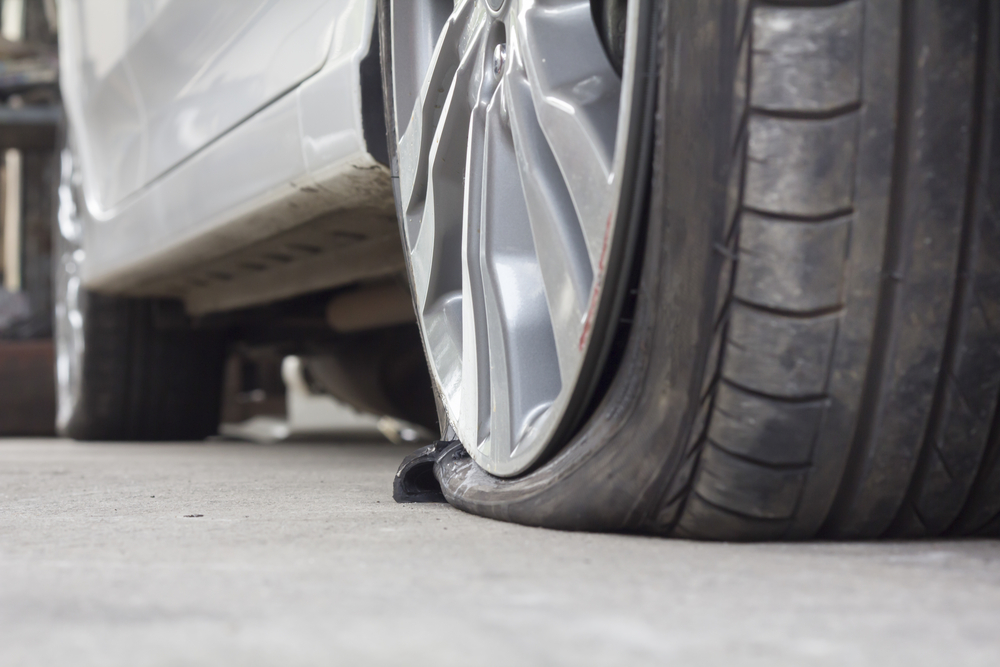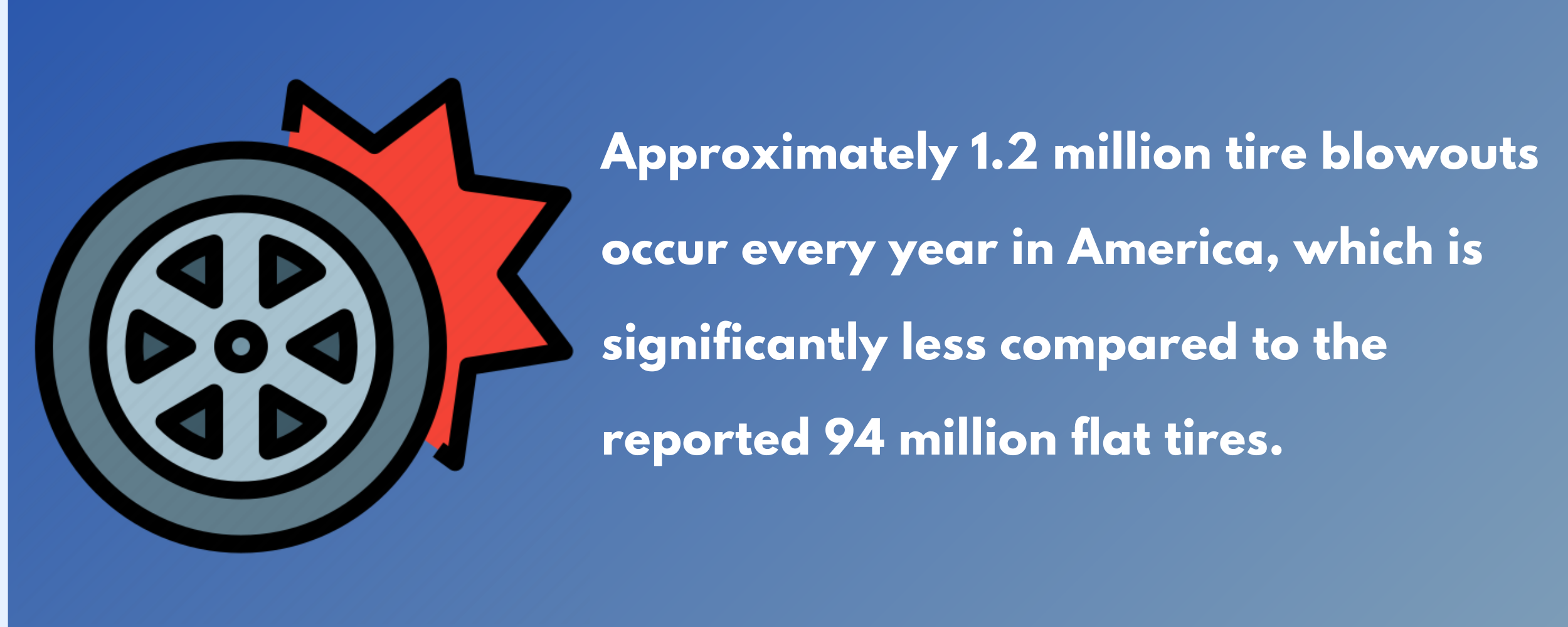
Key statistics:
- An estimated 1.2 million tire blowouts occur every year in America. Just for a perspective, there are over 94 million flat tires reported every year.
- Tire incidents cause an estimated 82,000 crashes each year accounting for about 1.3% of total vehicle crashes in America.
- More than 2,000 of those crashes are blowout-related [10]
- 1 in 270 crashes between 2000-2015 was caused by tire failure [10]
- There are an estimated 700 fatalities per year due to tire-related crashes [3] contributing 2% of the total fatal crashes.
- An estimated 11,000 injuries result from tire-related crashes which makes up about 0.067% of total injuries due to crashes.
- Low tire pressure is the main cause of tire blowouts [3]
- Americans put 2.9 trillion miles on their tires in 2020 [3]
- Only four out of five drivers, or 19%, properly inflate their tires [3]
- Properly inflating tires can extend their lifespan by 4,700 miles and save you up to 11 cents per gallon on fuel [3]
- Tires lose about 1 PSI of tire pressure each month [7]
- The closer the driving speed is to 75 mph, the higher the likelihood of failed tires, leading
to more potential blowouts [9]

Tire blowouts cause crashes and fatalities every year
It’s easy to adopt an “it’ll never happen to me” mentality. However, tire incidents are to blame for an estimated 82,000 crashes each year. Out of those crashes, an estimated 2,000 are blowout-related [10].
To further show how common these incidents are, one study revealed that between the years 2000 and 2015, one in every 270 crashes was caused by tire failure [2]. Alarmingly, these crashes can be quite fatal. In fact, there were close to 700 fatalities in just one year due to tire-related crashes [3].
What is a tire blowout?
What to do if you experience a tire blowout?
Tire blowouts are not just startling—they can be downright frightening. From the loud noise of
the initial blowout to the jerk of the steering wheel which often ensues, it makes sense that our initial instinct is to immediately switch from the accelerator over to the brake pedal. Similar to hydroplaning, however, slamming on the brakes is not recommended, as this causes wheels to
lock and leads to loss of control of the vehicle [4].
Instead, experts recommend taking the following steps should you experience a tire blowout [3,4]:
- Try your best not to panic. Keeping the vehicle balanced and controlled is crucial.
- Remember not to slam on the brakes or try to overcorrect a pulling steering wheel.
- Instead, gently press the accelerator (if safe to do so) to maintain your vehicle’s speed.
- Hold the wheel with both hands.
- Gradually remove your foot from the accelerator to begin losing speed.
- If you have the car under control, begin steering toward a safe pull-off space. Use minimum braking and coast until you lose speed, if possible [8].
- Pull over when you can safely do so.
Front versus rear wheel blowout
Tire blowout causes
So what, exactly, causes tire blowouts? Many mistakenly believe that too much air pressure in
tires causes them to burst; however, it’s actually the opposite. For the most part, tire blowouts are the result of low air pressure and can be triggered by the following [5]:
- Excess weight caused by overloading the vehicle
- Damage caused by impact, either immediate or delayed
- A large gash in the tire, causing immediate air loss
- A small puncture that creates a slow air leak
Other risk factor
While too little pressure is the leading cause of tire blowouts, the other top causes include road conditions and the type of vehicle involved in the crash.
Vehicle type:
Because SUVs have more space than smaller passenger cars, they are often loaded up with
both cargo and people. This extra weight puts strain on the tires which can cause them to fail[10]. In fact, 45% of SUVs that had pre-crash tire issues—such as underinflated tires—rolled over [2]. Studies show that SUVs are the type of vehicle most likely to be involved in a rollover crash [2]. Cars, pickups, and vans with pre-crash tire issues, on the other hand, rolled over less than 25% of the time [2].
Road conditions:
Regions that experience extreme temperatures are also more susceptible to blowouts, as the changing temperatures can lead to potholes [9]. Roads with potholes, as well as curbs, uneven roads, and construction areas with debris, nails, or other sharp objects can lead to punctures in the tire and therefore potential blowouts [11]. These issues are only exacerbated when driving on higher-speed roads [11].
While colder weather can lead to lower tire pressure, high road temperatures can overheat tires, especially if they’re any bit underinflated, which in turn increases the chances of a blowout [12].
Finally, while blowouts can occur at any speed, studies show that the closer the driving speed is to 75 mph, the higher the likelihood of failed tires, which can lead to more blowouts [9].
Prevention and maintenance
Fortunately, most tire blowouts are completely preventable. With Americans putting 2.9 trillion
miles on their tires in 2020 alone, it’s important to invest time in maintenance [3]. While proper tire maintenance regarding balance and alignment, tire tread, and tire rotation is important for your safety (and your wallet), checking your tire pressure is the most important aspect of tire maintenance, which can greatly reduce your risk of experiencing a blowout on the road [3].
Pound per square inch (PSI) is used to measure air pressure in tires. Bridgestone defines PSI as “the minimum amount of air pressure needed to support your vehicle at its maximum load” [7]. Tires lose about 1 PSI of tire pressure each month, on average, so it’s recommended to check your tire pressure at least once per month to ensure both your safety and tire durability[7]. To ensure the most accurate measurements, experts suggest checking your tires when “cold,” or when the vehicle hasn’t been driving for at least three hours [3].
How to check your tire’s air pressure
It can be all too easy to ignore the little tire pressure symbol that lights up on a vehicle’s
dashboard, but as we’ve seen above, keeping up with your tire pressure is paramount. Not sure where to start?
Below are the steps you can take to check your tire pressure in order to minimize your risk of a tire blowout [3]:
- Recommended tire pressure should come from the vehicle manufacturer, not the tire manufacturer. To find this, check the owner’s manual or the Tire and Loading. Information Label found on the driver’s side door, edge, or door jamb.
- Check each tire’s pressure.
- If the pressure is too high, lightly press on the tire valve stem with the edge of the tire gauge to slowly release excess air until you reach the correct PSI.
- If the pressure is too low, add the missing pounds of pressure until each tire is at the correct PSI.
Tire maintenance equates to savings
While safety is the driving force, the added benefit of proper tire maintenance is savings in the long run. For example, proper tire inflation can help you save on fuel—up to 11 cents per gallon[3]! Interestingly enough, only 19% of drivers take the time to keep their tires properly inflated, meaning four out of five drivers are losing money thanks to underinflated tires [3].
Keeping your tires properly inflated to your vehicle’s required PSI can also add an estimated 4,700 miles to a tire’s lifespan [3]. In addition to proper inflation, upkeep with tire rotation,
balance, and alignment makes tires last longer, thereby saving money on tire replacement.
Tire recalls
Of course, tire maintenance is useless on defective tires. The National Highway Traffic Safety Administration (NHTSA) issues recalls on unsafe tires. Many of these recalls come from consumer-issued complaints, however, so it is important to contact the NHTSA if you believe there is an issue with your tires.
One of the most notable tire recalls involved tire giant Firestone. The tire manufacturer recalled more than 14 million tires after blowouts were reported by many of its customers, resulting in over 270 deaths [19].
Conclusion
Sources:
1. National Safety Council
2. National Highway Traffic Safety Administration
3. National Highway Traffic Safety Administration
4. AllState
5. Tire Rack
6. DefensiveDriving.com
7. Bridgestone
8. HCW Law
9. Thomas Law Offices
10. United Tires
11. Study on the Stability Control of Vehicle Tire Blowout Based on Run-Flat Tire
12. How Stuff Works
